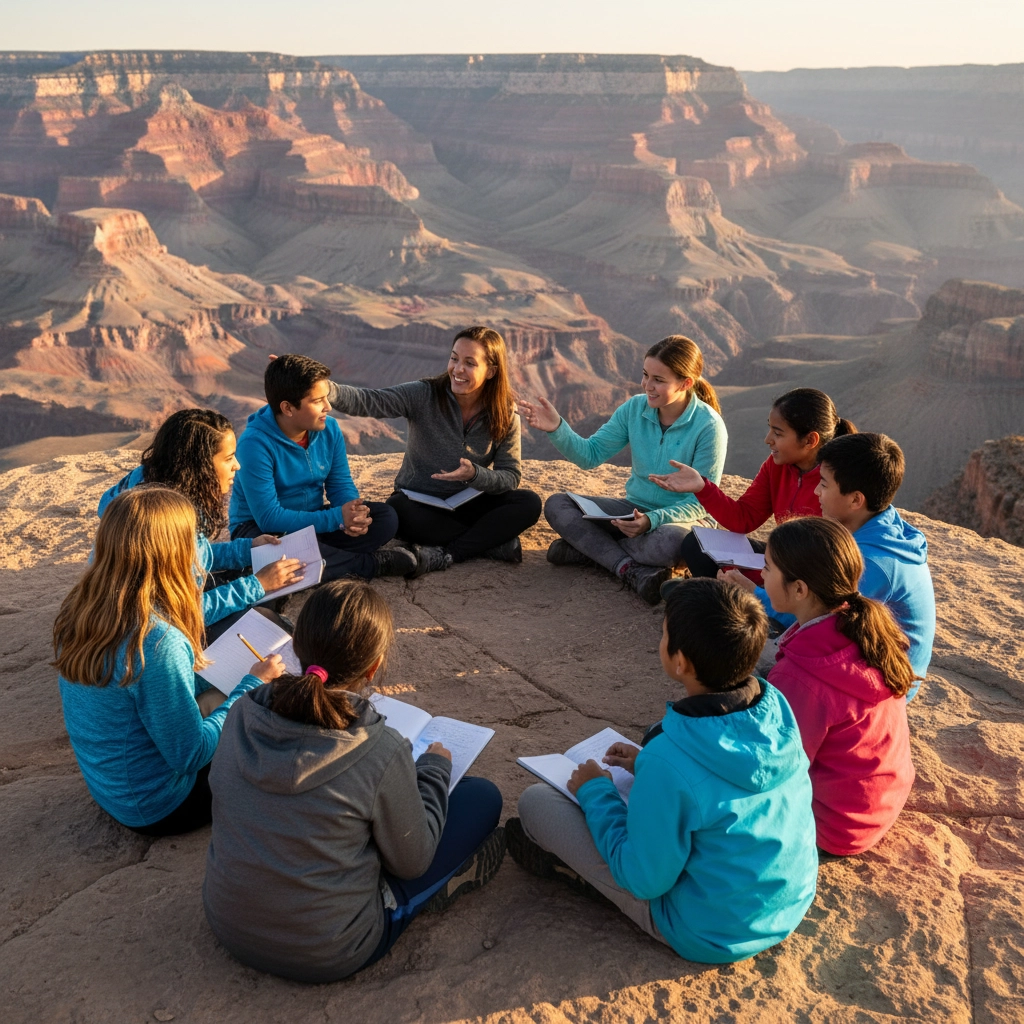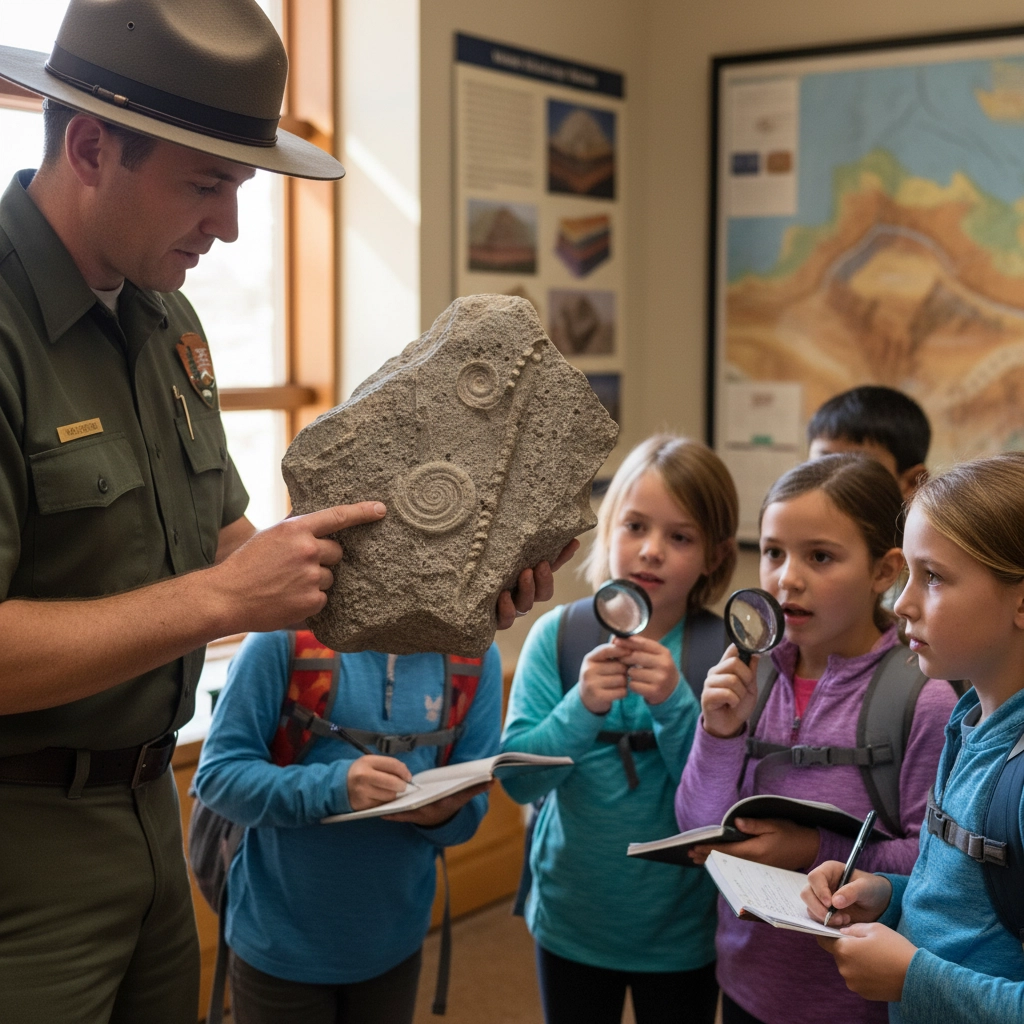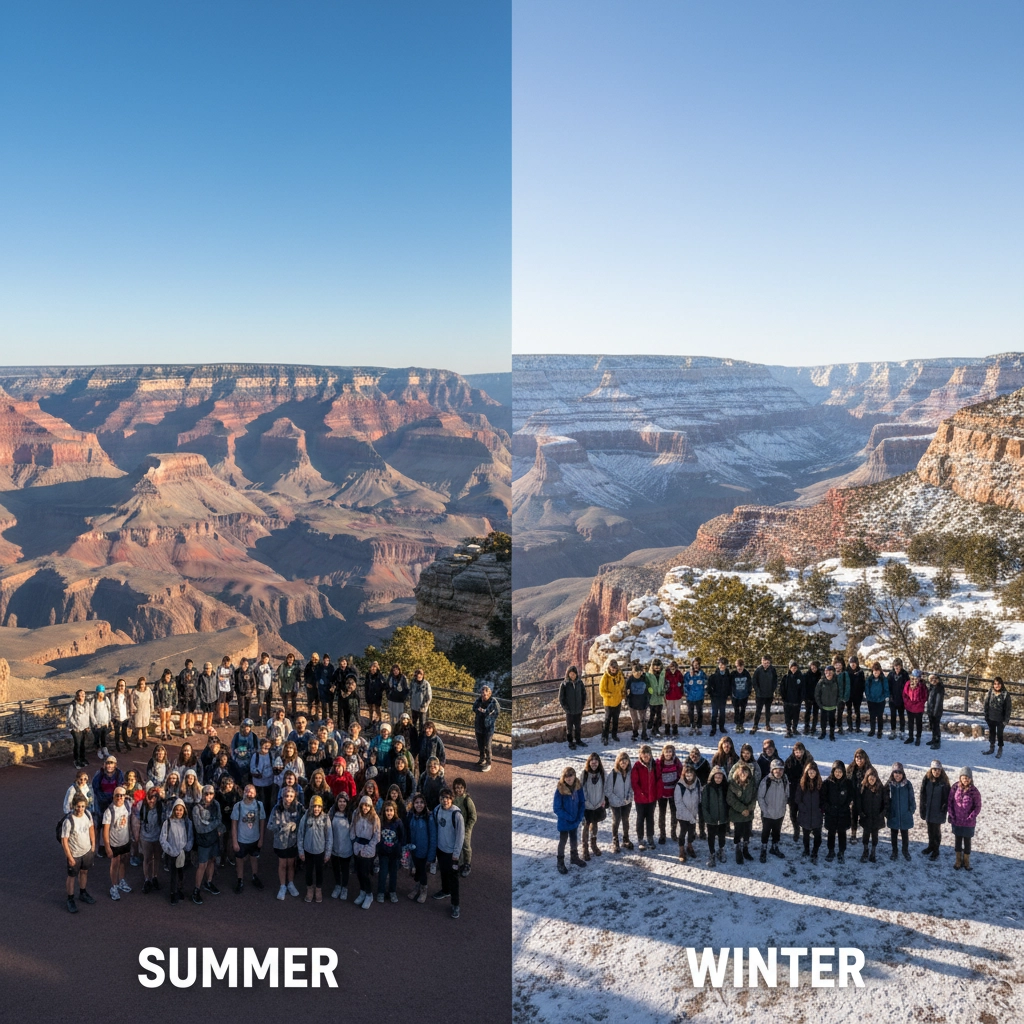5 Steps How to Plan an Unforgettable Grand Canyon School Trip (Easy Guide for First-Time Educators)
- Caleb Mullenix
- 9 minutes ago
- 6 min read
Planning your first Grand Canyon educational trip can feel overwhelming, but with proper preparation and systematic approach, you can create an unforgettable learning experience for your students. Ensuring the safety of students while maximizing educational outcomes requires careful planning, attention to detail, and understanding of the unique opportunities this natural wonder provides.
The Grand Canyon offers unparalleled opportunities for hands-on learning across multiple disciplines: geology, biology, environmental science, and cultural studies. Begin your planning process with confidence, knowing that systematic preparation will transform this iconic landscape into your outdoor classroom.
Step 1: Start Early and Set Clear Educational Objectives
Begin your planning process 6-12 months before your intended travel date. This timeline ensures availability of specialized educational programs and allows adequate preparation for all logistical requirements. Starting early demonstrates your commitment to providing students with the highest quality educational experience possible.
Establish clear educational objectives before contacting vendors or the National Park Service. Define specific learning outcomes that align with your curriculum standards. Consider how Grand Canyon experiences can reinforce classroom concepts in earth science, environmental studies, or cultural history. Create measurable goals such as "Students will identify three major rock layers and explain their formation processes" or "Students will analyze human impact on natural ecosystems."
Document your educational priorities in writing. Share these objectives with administrators, parents, and chaperones to ensure everyone understands the trip's academic purpose. This documentation also assists in securing administrative approval and educational funding opportunities.
Consider the personal growth opportunities beyond academics. Educational travel develops independence, problem-solving skills, and collaborative teamwork in authentic outdoor settings. Emphasize these character-building aspects when communicating with parents and school officials.
Research state and national curriculum standards that align with Grand Canyon experiences. This research strengthens your proposal and demonstrates the trip's educational value to administrators. Prepare to articulate how field experiences support standardized testing preparation and student achievement goals.

Step 2: Understand and Reserve Educational Programming
The Grand Canyon offers specialized ranger-led programs designed specifically for student groups. These programs support state science standards and provide expert instruction at no additional cost. Contact the National Park Service Education Team immediately after establishing your travel dates.
Priority Educational Programs to Consider:
Geo-Glimpse Program: Interactive demonstrations at the Yavapai Geology Museum feature hands-on rock sample examinations. Students analyze actual canyon specimens while learning geological time scales and formation processes. This program directly supports earth science curriculum requirements.
Fossil Walk Program: A moderate half-mile hike reveals marine creature fossils from ancient ocean environments. Students examine evidence of the canyon's underwater past while developing observation and analytical skills. Ensure your group's physical fitness level matches this program's requirements.
Condor Talk Program: 45-60 minute sessions focus on endangered species conservation and California Condor reintroduction efforts. Students learn about human impact on wildlife populations and conservation success stories. This program reinforces environmental science and stewardship concepts.
Junior Ranger Program: Available for ages 4-14, allowing students to earn official National Park Service badges while learning about canyon formation and Native American cultural connections. Students complete hands-on activities and demonstrate knowledge through interactive presentations.
Evening Cultural and Natural History Programs: In-depth explorations of canyon formation processes and ecosystem relationships. These programs extend learning beyond daylight hours and provide comprehensive understanding of natural systems.
Submit educational fee waiver requests through proper National Park Service channels. Ensure all documentation includes official school letterhead and administrator signatures. Request written confirmation of all program reservations and fee waiver approvals.
Popular programs fill quickly during peak academic seasons. Reserve your preferred programs immediately after confirming travel dates. Develop backup program options in case primary selections are unavailable.
Step 3: Create a Detailed Timeline and Coordinate Logistics
Organize your planning process into three distinct phases to ensure comprehensive preparation and minimize overlooked details.
6-12 Months Before Travel: Contact the National Park Service for program reservations and submit educational fee waiver requests with required documentation. Establish a preliminary budget including transportation, accommodation, meals, and program fees. Secure school administrative approval through formal proposal submission. Begin parent communication with initial trip announcements and permission slip distribution.
Create a comprehensive contact database including all students, parents, chaperones, and emergency contacts. Establish clear communication protocols for trip updates and emergency procedures.
3-6 Months Before Travel: Finalize all ranger program confirmations and create detailed day-by-day itineraries. Coordinate with school transportation departments to arrange vehicle reservations and driver requirements. Establish emergency communication protocols and evacuation procedures. Develop pre-visit curriculum activities that prepare students for field experiences.
Organize chaperone recruitment and conduct mandatory training sessions. Ensure adequate adult supervision ratios meet school policy requirements. Verify all chaperones complete background checks and emergency contact information.
1-3 Months Before Travel: Distribute comprehensive packing lists with weather-specific recommendations. Conduct parent information meetings to review itineraries, emergency procedures, and behavioral expectations. Prepare detailed student safety briefings covering trail safety, wildlife encounters, and group protocols.
Coordinate final details with food service providers and accommodation facilities. Confirm all transportation arrangements and backup contingency plans. Review emergency medical information for all participants and ensure proper medication protocols.

Step 4: Prioritize Safety and Weather Preparation
The Grand Canyon presents unique environmental challenges requiring meticulous safety preparation. Temperature variations between rim and inner canyon areas can exceed 40 degrees Fahrenheit, with summer inner canyon temperatures frequently exceeding 100°F while rim temperatures remain comfortable.
Mandatory Weather Preparation Requirements: Establish layered clothing systems for all participants to manage temperature fluctuations throughout the day. Require wide-brimmed hats, high-SPF sunscreen, and UV-protective sunglasses for all outdoor activities. Provide refillable water bottles for each student and implement scheduled hydration breaks every 30 minutes during hiking activities.
Develop emergency weather protocols including lightning safety procedures and severe weather shelter locations. Share these protocols with all students, parents, and chaperones before departure.
Physical Demands Assessment: Evaluate your students' age and fitness levels against planned activities. Winter conditions at higher elevations may include snow and ice, particularly affecting North Rim access from mid-October through mid-May. Adjust itineraries based on seasonal accessibility and student capabilities.
Create clear behavioral expectations for trail safety, including staying with designated groups, following designated paths, and maintaining appropriate distances from cliff edges. Conduct safety briefings before each outdoor activity.
Emergency Preparedness: Establish communication protocols with school administrators and parents for regular check-ins. Carry emergency contact information for all participants and maintain communication devices for remote areas. Coordinate with local emergency services and identify nearest medical facilities.
Prepare comprehensive first aid supplies and ensure chaperones understand basic emergency procedures. Document all safety protocols in writing and review them with all participants before departure.
Step 5: Develop Pre-Visit and Post-Visit Learning Activities
Extend educational impact beyond the field experience by creating curriculum continuity that reinforces learning objectives before, during, and after your Grand Canyon visit.
Pre-Visit Preparation: Develop classroom activities that introduce key concepts students will encounter during field experiences. Create lessons covering geological time scales, rock formation processes, and ecosystem relationships specific to Grand Canyon environments. Utilize available educational resources including interactive story maps, documentary films, and educational booklets.
Assign students specific observation roles during the trip, such as geology recorder, wildlife observer, or weather monitor. This preparation ensures active engagement and deeper learning during field experiences. Provide students with field journals and observation worksheets customized for Grand Canyon activities.
During-Visit Documentation: Encourage students to maintain detailed field notes, sketches, and photographic documentation of their observations. Implement structured reflection activities each evening to reinforce daily learning experiences. Create opportunities for students to share discoveries with peers through informal presentations.
Post-Visit Reinforcement: Schedule follow-up classroom sessions that analyze field observations and connect experiences to curriculum standards. Encourage students to research additional information about topics that captured their interest during the trip. Create presentation opportunities where students share knowledge with other classes or school assemblies.
Develop assessment activities that measure achievement of pre-established learning objectives. Use field experience examples in subsequent classroom lessons to reinforce concepts and maintain engagement.

Partnering with Educational Travel Specialists
Consider consulting with experienced educational travel specialists who understand the unique requirements of school groups and can streamline your planning process. Professional guidance often prevents common oversights and ensures optimal educational outcomes while managing logistical complexities.
Appleseed Expeditions specializes in creating transformative educational experiences that combine academic rigor with adventure learning. Our expertise in coordinating Grand Canyon school trips ensures your students receive maximum educational value while maintaining the highest safety standards. We handle complex logistics, coordinate with National Park Service programs, and provide comprehensive support throughout your planning process.
The Grand Canyon offers your students an unparalleled opportunity to connect with natural systems, geological processes, and conservation principles in ways that textbooks cannot replicate. Through careful planning, clear objectives, and systematic preparation, your first Grand Canyon educational trip will inspire lifelong learning and create memories that extend far beyond the classroom.
Begin your planning process today with confidence, knowing that thorough preparation leads to extraordinary educational experiences that will benefit your students for years to come.



Comments